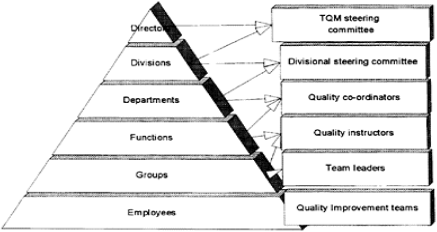SKEDSOFT
Introduction:
TQM is process-oriented. Internal customers are a part of the processes of the firm. The active participation of top management in the annual quality audit is an important part.
Everybody’s participation:
- To get everybody to participate demands the education and motivation of both management and employees.
- The firm’s management must get involved in as many education and training activities as possible. In our view, the active participation of top management in the annual quality audit is an important part of these activities, the effect of which will quickly filter down throughout the organization.
- Department managers will make demands on middle managers, who will make demands on their subordinates and so on down the hierarchy.
- Deming’s seventh point of his plan to implement TQM will be a natural consequence of the diffusion of the quality message: ‘Management must ensure that every employee in the company participates actively in a team (work team, quality circle).’
- Through its active and committed participation in the quality audit and by making the necessary organizational changes, management has thus shown a leadership wholly in keeping with the Japanese definition of leadership.
To realize the TQM vision, management must believe ‘that it will help’ to involve all employees. The next condition is that management also invests in the education and training of all employees at all levels in:
1. Identifying defects and problems.
2. Finding the causes of defects and problems.
3. Prevention, i.e. preventing the causes of defects and problems. A condition for effective prevention is that employees have completed points 1 and 2 and that, on the basis of a causal analysis, they make suggestions for and implement quality improvements.
4. Start again.
Model of the parallel organization:
- Parallel organization is extremely well organized but not as a part of the formal organizational structure.
- At the top of the parallel organization is the firm’s overall steering committee for TQM and under this, the quality improvement teams.
- If the firm is divided up into divisions, then the next level would be a divisional steering committee.
- Under this, a department coordinator for quality improvement is appointed for each department.

Fig: The parallel quality organization
The powers and responsibilities of the quality organization are as follows:
1. To set meaningful and ambitious quality goals for the individual team/employees. This is done is close co-operation with the teams/ employees who fulfill the goals.
2. To ensure that quality improvements are started and implemented in all parts of the organization, both by top-down and bottom-up initiatives. Quality improvement suggestions can come both from quality improvement teams and individual employees. The annual and three-year plans ensure that the improvements do not peter out.